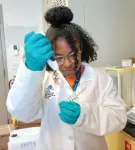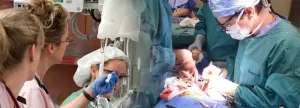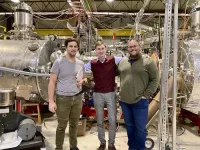(Press-News.org) When it comes to the Colorado River, history often repeats itself—but it doesn’t have to.
That’s the take-home message from CU Boulder hydrologist Shemin Ge, who will present a little-known piece of history from the river this Thursday at the American Geophysical Union (AGU) meeting in San Francisco.
The story of hydrologist Eugene Clyde La Rue, Ge said, may help to explain the current water crisis facing many states in the American West.
Ge’s presentation centers around a decision made in 1922, when the seven men who made up the Colorado River Commission came to an agreement to divvy up water on the Colorado River. This waterway winds over 1,450 miles and through seven states. The commission relied on an estimate from the U.S. Reclamation Service suggesting that 16.4 million acre-feet of water ran through the river at Lees Ferry, Arizona, every year. (An acre-foot equals the amount of water you’d need to submerge an acre of land to a depth of 1 feet).
But, Ge said, the commission also failed to consider a second, less convenient study from 1916. Relying on his own field data, La Rue, working for the U.S. Geological Survey, had calculated that the Colorado River discharged just 15 million acre-feet of water.
“It’s intriguing how such good work at the time was ignored, whether it was intentional or just out of ignorance,” said Ge, professor in the Department of Geological Sciences at CU Boulder.
She worries it may be happening again.
In 2022, Lake Mead and Lake Powell, the two main reservoirs on the Colorado River, dried up to levels never seen before, raising concerns that they could be heading for a “dead pool” state—in which water could flow in but not out of the reservoirs.
Currently, the seven states within the Colorado River Compact are working to revise a suite of agreements and guidelines by 2026. Ge hopes that, this time, leaders will work closely with scientists and a range of community members, particularly Indigenous groups—all to build a Law of the River that accounts for how much water actually exists in the West, now and in the future.
That will become more important, she said, as climate change continues to melt the West’s dwindling snowpacks.
“There’s so much we can learn from history to improve how we’re managing our water,” Ge said. “Right now, I don’t think we’re doing enough.”
Traveling the river
She first learned about La Rue’s story from the 2019 book, “Science Be Dammed” by Eric Kuhn and John Fleck. She and her colleagues wrote about their insights this summer in the magazine “Eos.”
Think of it as a tale of two estimates.
Beginning in 1914, La Rue hiked across much of the river and its tributaries, collecting first-hand data on the flow of water. That included taking measurements of the depth of the river and its flow speed.
“We still do this in our intro to geology courses,” Ge said. “It’s very low tech, but elegant.”
To come to its 16.4 million acre-feet assessment, in contrast, the Colorado River Commission, led by Secretary of Commerce and future President Herbert Hoover, relied on a much less rigorous study: measurements taken at just one site near Yuma, Arizona, hundreds of miles south of Lees Ferry.
“They took the larger number,” Ge said. “A larger number probably made the allocations easier to negotiate because there was more water to divvy up.”
The 40 million people who depend on the Colorado River for their water today may be paying the price.
Learning from the past
Today, research pegs the flow of the Colorado River at around 13 million acre-feet per year, making even La Rue’s modest estimates seem like a fantasy.
The Colorado River Compact, however, continues to allot water based on the 16.4 million acre- feet value: Colorado, New Mexico, Utah and Wyoming together claim 7.5 million acre feet. Arizona, California and Nevada get the same, and Mexico supposedly draws 1.4 million.
Ge hopes that, in the lead up to 2026, those seven states will do what Hoover couldn’t—draw on the best available science to develop realistic estimates of how much water will likely flow down the river decades from now. She added that Indigenous groups need to be an important part of that process. Several tribes hold some of the most senior rights to water in the western U.S. but lack the infrastructure to access much of their share.
“We’re not talking enough about how much water is in the Colorado River,” Ge said. “We talk about droughts, infrastructure and water conservation. But shouldn’t the first order of business be to see how much water we actually have? It’s much less than we think.”
END
How an overlooked study over a century ago helped fuel the Colorado River crisis
2023-12-15
ELSE PRESS RELEASES FROM THIS DATE:
Basic monthly income trial at USC shows promise with significant reduction in homelessness
2023-12-15
Researchers at the Center for Homelessness, Housing, and Health Equity Research at the University of Southern California released an interim report on the first six months of a randomized controlled trial to study the impact of a basic income and social support intervention for 103 individuals experiencing homelessness in Los Angeles County and the San Francisco Bay Area.
Two key findings so far are that participants in the Miracle Money study who received $750 per month were less likely to remain unsheltered and closer ...
New gene therapy could significantly reduce seizures in severe childhood epilepsy
2023-12-15
UCL researchers have developed a new gene therapy to cure a devastating form of childhood epilepsy, which a new study shows can significantly reduce seizures in mice.
The study, published in Brain, sought to find an alternative to surgery for children with focal cortical dysplasia.
Focal cortical dysplasia is caused by areas of the brain that have developed abnormally and is among the most common causes of drug-resistant epilepsy in children. It frequently occurs in the frontal lobes, which are important for planning and decision-making. Epilepsy in focal cortical dysplasia is associated with comorbidities, including learning disabilities.
Although surgery to remove the affected brain malformation ...
Mount Sinai receives $1.3 million from the National Institutes of Health to support program that introduces high school students to virus surveillance
2023-12-15
The Icahn School of Medicine at Mount Sinai has received more than $1.3 million from the National Institute of General Medical Sciences of the National Institutes of Health (NIH) to expand the New York City Virus Hunters program. The program engages high school students from communities historically underrepresented in science in the first large-scale citizen science effort to catalog and map circulating avian influenza and avian paramyxoviruses in New York City’s wild birds. The goal is to track emerging viruses and to prevent future outbreaks.
Wild birds can disseminate infectious ...
UM School of Medicine awarded up to $7.3M from DARPA to drive innovation in trauma triage technology, improve mass casualty response efforts
2023-12-15
In an effort to better optimize the triage of patients during mass casualty events, University of Maryland School of Medicine (UMSOM) researchers are receiving up to $7.3 million in funding from the Defense Advanced Research Project Agency (DARPA) for vital new research. The funding will be used to support a study that will collect data over the next 3.5 years on trauma patients with the aim of identifying and implementing lifesaving advancements in medical triage for large-scale mass casualty incidents.
“The importance of early interventions in trauma is described as the concept of the ‘golden ...
Transportation planning goes virtual
2023-12-15
Freight transportation is a backbone of the US economy — and a significant contributor to US greenhouse gas emissions. In fact, freight accounts for nearly 10% of annual U.S. emissions,ISE Dan Doulet Faculty Fellow and Professor Xueping Li points out. Li and an interdisciplinary, multi-institutional team have been awarded funding from the US Department of Energy to launch a first-of-its-kind, national-scale undertaking to address freight’s impact on climate change — and climate change’s impact on this vital sector.
Funding from DOE’s Advanced Research Projects Agency-Energy (ARPA-E) is highly competitive. “Any ...
Zhou’s new tech has low-income housing covered
2023-12-15
When looking for ways to reduce their carbon footprint, most people think of first of their car, not their house. Surprisingly, however, buildings make up one of the largest energy-consuming sectors of the US economy, accounting for 39 percent of the country’s total energy use.
“Heating and cooling are among the most energy-intensive parts of building operations,” said Associate Professor of Civil and Environmental Engineering Nick Zhou, who leads UT’s Sustainable and Adaptive Built Environment Group in ...
New framework to identify genetic risk of disease could lead to targeted therapeutics
2023-12-15
Genome-wide association studies (GWAS) on patient blood samples are useful for identifying the genetic basis of blood cell traits and their links to common diseases. While previous experiments have focused on characterizing clinical parameters such as cell count, few have evaluated the dynamic effects of factors—such as inflammation, microbiome or medications—on blood cell contributions to disease development and progression. This lack of insight into underlying biological mechanisms behind such chronic progressive conditions has hindered ...
Newly developed material gulps down hydrogen, spits it out, protects fusion reactor walls
2023-12-14
MADISON – University of Wisconsin–Madison engineers have used a spray coating technology to produce a new workhorse material that can withstand the harsh conditions inside a fusion reactor.
The advance, detailed in a paper published recently in the journal Physica Scripta, could enable more efficient compact fusion reactors that are easier to repair and maintain.
“The fusion community is urgently looking for new manufacturing approaches to economically produce large plasma-facing components in fusion reactors,” says Mykola Ialovega, a postdoctoral researcher in nuclear engineering and engineering physics at ...
Tufts University announces Second Annual Cellular Agriculture Innovation Day
2023-12-14
Tufts University, home to the world’s largest concentration of academic researchers working on cultivated meat, will be hosting its second annual Cellular Agriculture Innovation Day on January 11, 2024. The day-long event will be held at Tufts’ Joyce Cummings Center in Medford, following a year of major developments in the industry — including regulatory approval of cultivated meat in the United States. Bringing together researchers, entrepreneurs, policymakers, and investors, Cellular Agriculture Innovation Day is an opportunity for candid ...
DOE’s Office of Science releases vision outlining the path to advancing fusion energy science and technology
2023-12-14
Washington, D.C. – The Office of Fusion Energy Sciences (FES), at the U.S. Department of Energy’s Office of Science, announced the release of its vision, Building Bridges: A Vision for the Office of Fusion Energy Sciences, during the Fusion Energy Sciences Advisory Committee hearing on December 13, 2023. This FES vision enables DOE to establish the steps needed to help advance fusion energy, including addressing key science and technology gaps in the supply chain and industry, bringing the United States one step closer to achieving net-zero emissions by 2050.
Fusion, the process that powers ...



